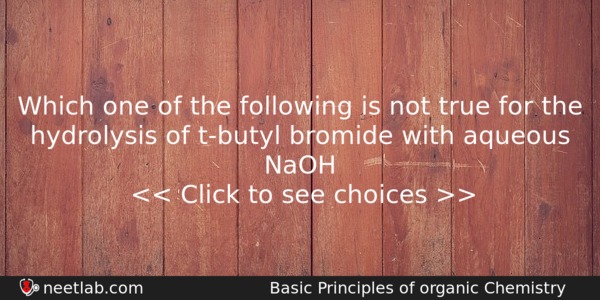| ⇦ | 
| ⇨ |
Which one of the following is not true for the hydrolysis of t-butyl bromide with aqueous NaOH
Options
(a) reaction occurs through the SN1 mechanisum
(b) The intermediate formed is a carbocation
(c) Rate of the reaction doubles when the concentration of alkali is double
(d) Rate of the reaction doubles when the concentration of t-butyl bromide is double
Correct Answer:
Rate of the reaction doubles when the concentration of alkali is double
Explanation:
No explanation available. Be the first to write the explanation for this question by commenting below.
Related Questions: - Which of the following statement about the member of any one homologous series
- Which of the following is electron-deficient?
- For making distinction between 2-pentanone and 3-pentanone the reagent to be
- In the Kjeldahl’s method for estimation of nitrogen present in a soil sample
- A compound gives a positive test with I₂/NaOH and is extracted from benzene
Topics: Basic Principles of Organic Chemistry
(124)
Subject: Chemistry
(2512)
Important MCQs Based on Medical Entrance Examinations To Improve Your NEET Score
- Which of the following statement about the member of any one homologous series
- Which of the following is electron-deficient?
- For making distinction between 2-pentanone and 3-pentanone the reagent to be
- In the Kjeldahl’s method for estimation of nitrogen present in a soil sample
- A compound gives a positive test with I₂/NaOH and is extracted from benzene
Topics: Basic Principles of Organic Chemistry (124)
Subject: Chemistry (2512)
Important MCQs Based on Medical Entrance Examinations To Improve Your NEET Score
18000+ students are using NEETLab to improve their score. What about you?
Solve Previous Year MCQs, Mock Tests, Topicwise Practice Tests, Identify Weak Topics, Formula Flash cards and much more is available in NEETLab Android App to improve your NEET score.
Share this page with your friends

Leave a Reply